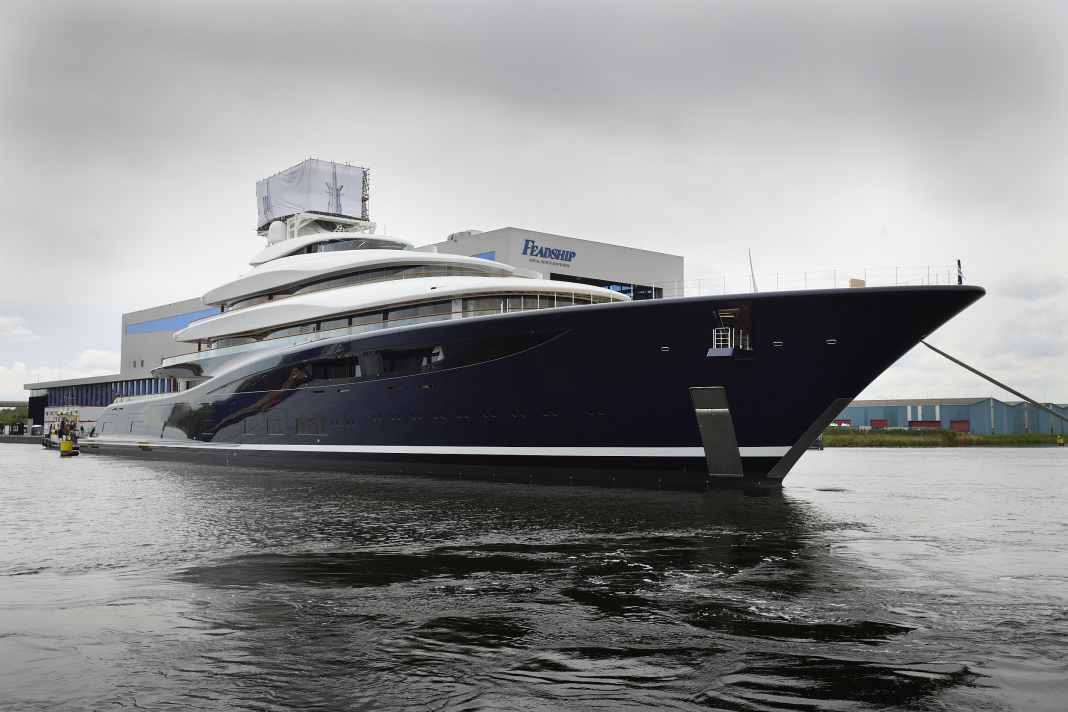119-metre Feadship: The first hydrogen superyacht floats - and is for sale
Sören Gehlhaus
· 09.05.2024






Owners who are looking for individualised excellence come to Feadship. The Dutch shipyard group emerged from an export association and is one of the world's top addresses for custom-built yachts from 40 to 120 metres in length. Feadship's ambitious goal is to produce "net zero" yachts by 2030. The first step was taken with the 118.80 metre long "Hydrogen" project 821, and the right owner was found beforehand. The aesthetic and technical orientation of these solitaires depends largely on the client's taste. The most recent Feadship had good prerequisites: It is the largest motor yacht ever launched in the Netherlands and trumps the recently launched "Launchpad" by 80 centimetres. Above all, however, the new flagship has 30 per cent more volume - flab that is not necessarily visible on the gigayacht.
The designers at RWD countered the "stacked" appearance - the owner's deck is 37 metres from the water surface - with flowing, modern lines, a large number of concave surfaces and comparatively short decks. However, 821 does not have a straight stem and lacks a maximally long waterline. The aim was to conceal a hydrogen tank below deck, in which compressed liquid hydrogen is stored at -253°C. Hydrogen is light, one cubic metre of liquid hydrogen weighs 70 kg compared to around 800 kg per cubic metre of non-fossil diesel fuel (HVO or e-diesel). As safe storage on board requires a double-walled cryogenic tank, eight to ten times more space is needed to store hydrogen than the energy equivalent of diesel fuel, according to Feadship.
Hydrogen stored in a double-walled tank
The hydrogen (around four tonnes) from the 92 m³ tank is processed by 16 fuel cells into electricity and water in the form of steam. The latter by-product required ventilation shafts and the connection to the DC grid required many cables and control cabinets. In the end, the new reaction chambers extended the original LOA by four metres. With fuel cell technology alone, the Feadship flagship should be able to lie silently at anchor for a week or travel emission-free at ten knots for a limited time, for example while leaving harbours or travelling in protected marine areas. The liquid hydrogen is not sufficient for long crossings; the focus was on the hotel load. According to Yacht Environmental Transparency Index (YETI) 70 to 78 per cent of a yacht's total energy consumption, with heating and air conditioning as the largest consumers. For longer journeys or when pure hydrogen is not available, HVO-burning MTU generators supply the electricity for the 3200 kW pod drives from ABB. The Feadship, delivered in 2023, proves that this works "Obsidian". In contrast to the 84-metre Feadship, which carries batteries with a total of 4.5 megawatt hours, Project 821 has "only" 543 kilowatt hours.
Fuel cells are ready for methanol
Feadship emphasises that the fuel cells developed for Project 821 can also process methanol. To be CO2-neutral, however, this would have to be green, i.e. produced using green hydrogen. And this - also known as the champagne of the energy transition - is produced by electrolysis of water using electricity from renewable energy sources. Before the electrochemical reaction in the fuel cell, methanol is converted into hydrogen by reformers using vapour. The alcohol is stored in similar containers to diesel, but in terms of calorific value, it has a volume around 2.4 times greater than diesel. Lürssen is currently pursuing the methanol fuel cell route with Cosmos" project. The Italian Sanlorenzo shipyard plans to launch a 50-metre format with fuel cells from Siemens Energy in the next few weeks, which will store 5,000 litres of methanol and will primarily be used for hotel operations.
Feadship makes pioneering work accessible to all
Although hydrogen fuel cell powered cars exist and fuel cells have been used as the primary power source in manned spaceflight for more than six decades, there have been no specifications for hydrogen storage and fuel cell systems in the maritime sector at class, flag state or even IMO level. Feadship, Edmiston and Lloyd's Register developed equipment, protocols and safety regulations. "The value of the research and the development of class and flag safety regulations for a completely new way of power generation is an advance that we are proud to have made available to all," said Jan-Bart Verkuyl, Feadship director and CEO of Royal Van Lent Shipyard. Next year, two Norwegian long-haul passenger and car ferries will enter service using the system developed with the PowerCell Group, a spin-off from Volvo, for Project 821.
Waste heat heats the pool and the rooms
Feadship is pursuing a holistic approach with Project 821; the heat recovery system is designed to be particularly efficient and includes the pool, jacuzzi, steam bath, underfloor heating and room air. Further savings are hoped for through an intelligent air conditioning system with sensors and an energy management system that automatically reduces the output of the air conditioning or heating in unoccupied rooms. Project 821 also has the most hull openings of any Feadship to date. A total of 14 balconies slide out of the side decks, taking their side railings or walls with them. In addition, there are five flaps that move upwards and seven that move downwards to form platforms.
The owner will probably never see his deck above the bridge with two bedrooms, two bathrooms and changing rooms, a gym, lounge and two offices, each with fireplaces. It is rumoured that Bill Gates has commissioned Project 821, but does not want to take delivery of it. Interested buyers are contacting Edmiston, but the British brokerage firm is not communicating a price.

